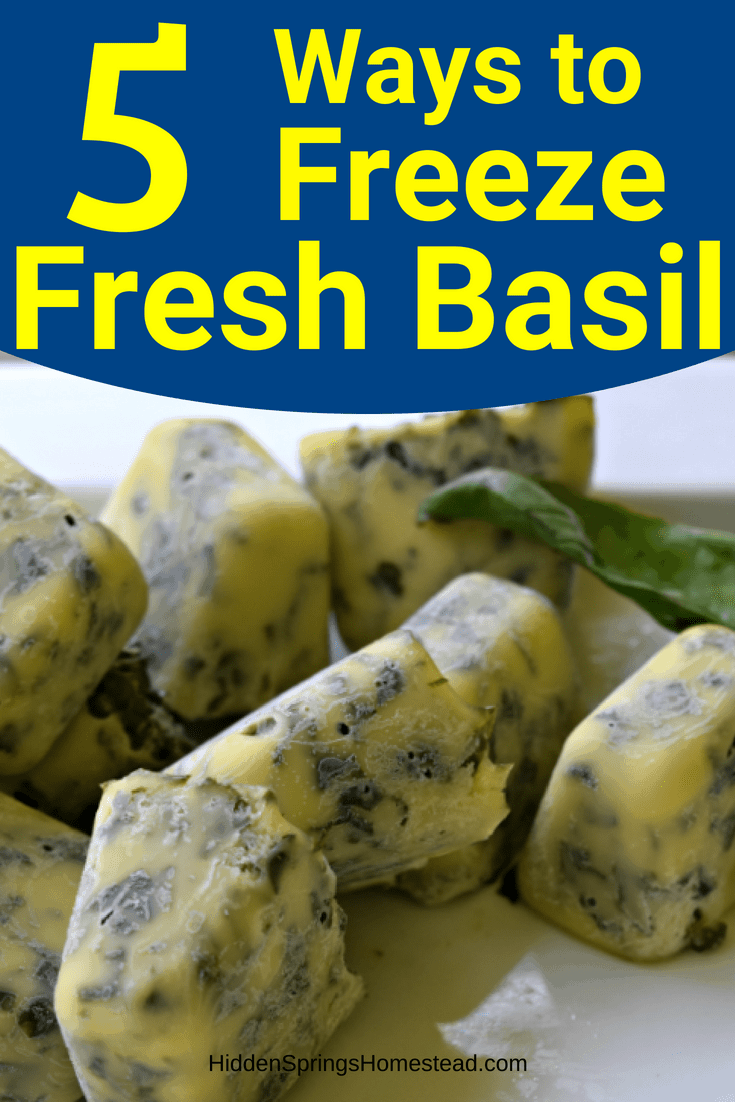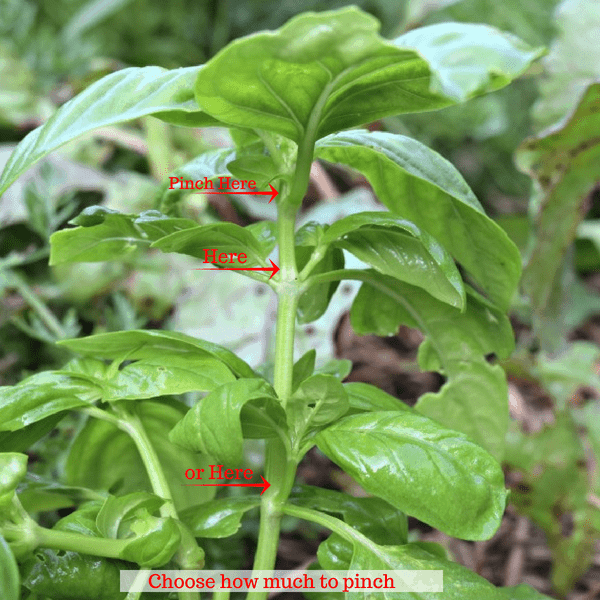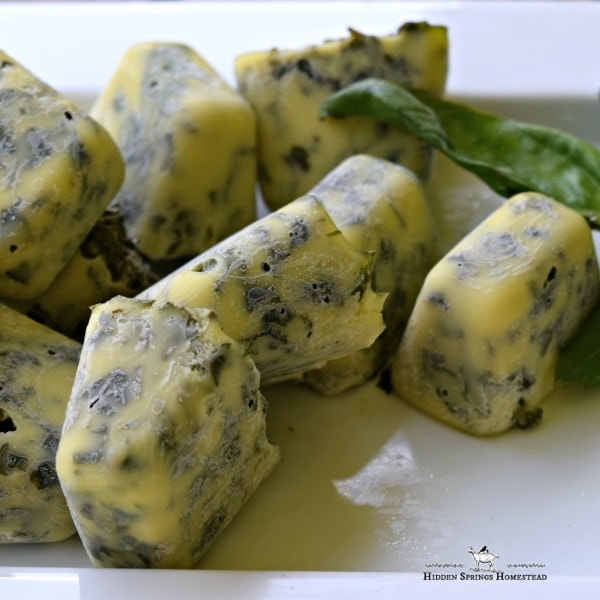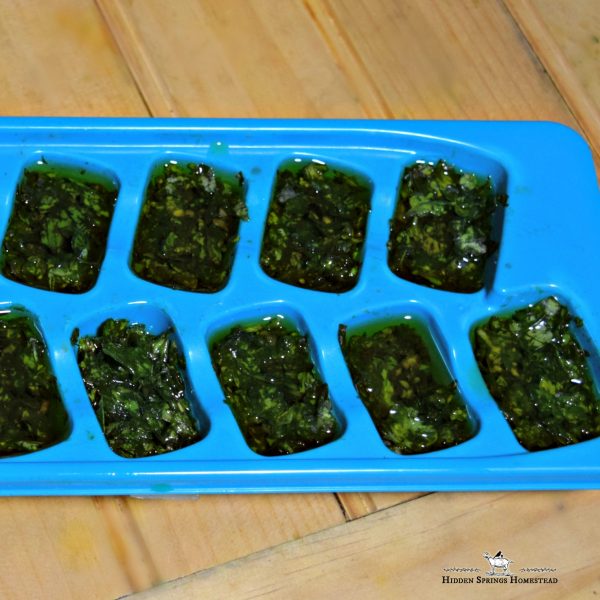Hidden Springs Homestead may earn a commission for purchases made after clicking links on this page. Learn More.
If you have an abundance of fresh basil from your garden and want to preserve its flavor for the winter, there are several easy ways to freeze it.
Today, we’ll explore five methods that will allow you to enjoy the fresh taste of basil even during the colder months. I will also share my personal favorite method for freezing fresh basil and why I believe it is the best option.
After all, basil is one of the easiest herbs to grow; it grows almost anywhere. The great news is since it grows so abundantly, it can be preserved in several ways.
Why I Prefer Freezing Basil
When I first began harvesting herbs for preservation, I was attracted to the idea of hanging them to dry.
It was not only because it was the only way I knew how, but I was attracted to the pretty pictures we often see when searching the internet.
But, air drying herbs is not always the best option. Not only are the leaves delicate on many herbs, but when they are hanging, they quickly lose their green color, get really dusty, and often turn black.
So I’ve found freezing basil leaves to be my favorite choice. Not only do the leaves stay green and attractive, but it also locks in the fresh flavor.
Uses for Frozen Basil
Frozen basil can be used in dinner recipes like my Chicken Parmesan Pizza, or it’s a great way to preserve it and use it when canning homemade spaghetti sauce or pizza sauce. Basil is also wonderful in this Carrot Top Pesto Recipe.
You can use it in many different ways. Anytime you have a recipe that calls for basil, you can take it out of the freezer and add it to your recipe.
It’s a great way to save money rather than buy those tiny bottles at the grocery store that are always so overpriced.
Harvesting Basil for Freezing
If you are growing basil, then you will need to know how to harvest basil.
Start by picking basil when the plant is only 6-8 inches tall. Harvesting leaves encourages the plant to produce more leaves and to continue growing.
The best time to harvest is early in the morning when the flavors are at their highest. Of course, it can be picked any time you need it – its flavor may not be as robust in the heat of the day.
On average, a well-maintained basil plant will produce 4-8 cups of basil in a season. This is why if you are growing basil, you probably have lots to store.

Harvesting in Small Amounts
You can pick only a few leaves at a time to use fresh. Cut or pinch off at the node where you see baby leaves growing out from the larger leaves and then give your basil a good drink of water.
Don’t fret by doing this; doing so encourages basil plants to grow bushier and larger.

Harvesting in Large Amounts
If you are over-ran by basil and need your plant to slow down a bit, you can slow it without killing it. You always want to harvest from the top down. That sounds strange because many other herbs harvest from the bottom up.
Start by removing the top one-third of the plant. Making sure that when you cut or pinch off, you are doing so at a leaf node where baby leaves sprouting. Don’t leave an exposed leafless stem.
Removing such a large amount at one time will help slow the plant’s production. It will be ready to harvest again in a few weeks rather than a few days.
Related: Quick Start Guide to Freezing Food at Home
Last Harvest of the Season
Basil does need to be harvested before it is hit with fall temperatures. It is a warm-season herb that like temperatures above 50 degrees.
If nighttime temps will be getting below 50, it is best to go ahead and harvest the whole plant. To do so, cut the stem off at ground level, remove all leaves and toss the stem into the compost pile.
All the leaves should be brought inside for drying and freezing.
How to Freeze Basil without it Turning Black
The secret to freezing basil without turning black is preserving it quickly. So don’t harvest it; leave it in the frig or on the counter.
Once it is harvested, the oxidation of the broken cell walls releases enzymes that cause it to turn dark. It often turns black, but it can turn a dark brown too.
So the best way to keep it from turning black is to harvest it when you can freeze it immediately. Otherwise, leave it on the plant until you are ready.
5 Ways To Freeze Fresh Basil
1. Flash Freeze – (Without Blanching)
This is a very simple method to do. It sounds difficult, but once you do it, it’s simple.
Harvest and wash basil leaves. Remove any stems and leaves with bad places.
- Before freezing, the basil needs to be completely dry. You can lay them out in a single layer and pat them dry with paper towels.
- But a much faster way is to use a salad spinner to remove any water that may be on the leaves. This is the spinner I use, and I love it! Just a couple of 2 or 3 good pulls, and the basil is dry.
- After the leaves are dried, single-layer them on a flat pan or cookie sheet. Put them into the freezer for 2-4 hours.
- They will need to be frozen when you remove them. (NOTE – you will need to work quickly; they begin to thaw immediately, and you don’t want this to happen)
- Place frozen leaves in a single layer inside a freezer-safe container. I use gallon-size Ziploc bags and place unbleached parchment paper between the layers. This prevents the leaves from freezing together.
- Store flat in the freezer.
2. Blanched or Whole
Preserving basil leaves whole or blanched is another easy way to freeze basil. It does require more prep work than flash freezing, but it’s not so hard.
Wash basil leaves with cold water – no need to dry them as you do with flash freezing.
- Place basil in a colander that fits inside the pot you will use for boiling water. (Basil will need to be removed from boiling water all at the same time – this is important) I have and use this set. I like the varying sizes that stack well for storage.
- Fill a large stock pot with water and bring water to a boil.
- In the meantime, fill a large bowl with water and ice for an ice bath.
- Dip basil leaves in a colander into the boiling water for 3-4 seconds and quickly remove.
- Immediately immerse into an ice bath. Remove from the ice bath using cooking tongs and drop them into a salad spinner to dry them.
- Remove leaves, one at a time, and put them inside a freezer-safe bag or container using a layer of parchment paper between layers. This will keep them from freezing together.
- Remove as much air as possible. Store flat in the freezer.
3. Chopped Basil – Frozen in Olive Oil
I told you I would share with you my favorite way to freeze fresh basil, and this is it!
I think a good fresh virgin olive oil and fresh basil are meant to be together. Not to mention how pretty it is.

As with all recipes to freeze fresh basil, begin by washing leaves and removing any long stems and black or bad spots.
- Place leaves in a chopper and chop until finely minced but not pureed. I have a big food processor, but my favorite way to evenly chop basil for preservation is to use this Ninja Food Chopper. It’s small and chops evenly without pureeing whatever is in it. It’s uniform in appearance and much faster than hand chopping.
- Fill each cube with spoons of chopped basil using a regular ice tray. As many as you like, I fill each cube about three-quarters of the way. Not totally full.
- Once all the sections are filled, pour into each of them Extra Virgin Olive Oil until it is full.
- Place in freezer, uncovered, for 24 hours.
- Remove from freezer and pop basil out of ice tray, and place in a labeled Ziploc bag.

4. Chopped – Frozen in Other Liquids
If you prefer not to use oil, you can substitute it with chicken or beef broth, bone broth, and even water.
Just follow the instructions for Frozen in Olive Oil. Only substitute oil with your liquid of choice.
The broth or water should be cold or at room temperature when you pour it into the ice trays. You don’t want to use hot and “cook” the basil.
Broth works well for soups and stews. Water works well for everything. Sauces, pasta dishes, and other recipes.

5. Pureed and Frozen
This can be done in 3 simple steps. Of course, wash basil and remove stems and bad spots.
- Add one tablespoon of olive oil to each cup of basil using a food processor. Process until pureed – about 2 minutes.
- Pour pureed basil into the ice tray, and fill all sections.
- Place in the freezer for 24 until frozen well. Remove from the tray and store in a labeled Ziploc bag.
How to Store Frozen Basil
Basil should be kept in the freezer, and only needed amounts should be taken out as needed.
Keep it in an air-tight container, single layer, using parchment paper between layers.
It will store for up to three months.
If freezing basil isn’t your preference for preserving basil, you can always try these 4 ways to dry fresh basil.
Fresh basil is my favorite herb to grow and eat as well. I love it, and my family loves it, so it is a win-win!
How about you? Do you grow fresh basil in your garden? If so, what is your favorite way to preserve it?
More Preserving Ideas
- Best Way to Freeze Broccoli
- How to Freeze Peppers
- How to Freeze Strawberries
- 4 Easy Ways to Preserve Peppers
- How to Freeze Okra
- Water Glassing Eggs, Preserving Fresh Eggs For Long-Term Shelf-Life

Connect with Hidden Springs Homestead!
Be sure to follow me on social media so you never miss a post!

Dianne Hadorn is the owner of Hidden Springs Homestead nestled in the hills of East Tennessee. She is a Master Gardener and enjoys helping others learn how to grow and preserve their own food and sharing tips for living a more self-sufficient lifestyle.

When it comes to broth or water, you did not state if frozen cubes should be started with hot or cold liquid.
Hi Bernie,
I edit the post to answer your question. I’ve never been asked this before and it’s such a great one. The broth or water will need to be either cold or room temperature. You don’t want to use a hot broth or water since it will cook and change the flavor or your fresh basil.
When I use broth, I open a pint off my canning shelf and pour it over the basil into each individual ice cube. Of course, if you don’t can homemade broth, a purchased broth will work as well.